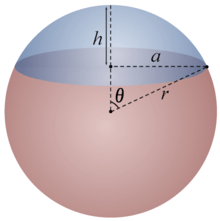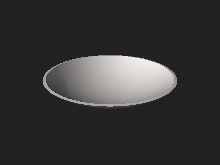Spherical cap
In geometry, a spherical cap or spherical dome is a portion of a sphere or of a ball cut off by a plane. It is also a spherical segment of one base, i.e., bounded by a single plane. If the plane passes through the center of the sphere, so that the height of the cap is equal to the radius of the sphere, the spherical cap is called a hemisphere.


Volume and surface area
The volume of the spherical cap and the area of the curved surface may be calculated using combinations of
- The radius of the sphere
- The radius of the base of the cap
- The height of the cap
- The polar angle between the rays from the center of the sphere to the apex of the cap (the pole) and the edge of the disk forming the base of the cap
| Using and | Using and | Using and | |
|---|---|---|---|
| Volume | [1] | ||
| Area | [1] |
If denotes the latitude in geographic coordinates, then .
The relationship between and is relevant as long as . For example, the red section of the illustration is also a spherical cap for which .
The formulas using and can be rewritten to use the radius of the base of the cap instead of , using the Pythagorean theorem:
so that
Substituting this into the formulas gives:
Deriving the surface area intuitively from the spherical sector volume
Note that aside from the calculus based argument below, the area of the spherical cap may be derived from the volume of the spherical sector, by an intuitive argument,[2] as
The intuitive argument is based upon summing the total sector volume from that of infinitesimal triangular pyramids. Utilizing the pyramid (or cone) volume formula of , where is the infinitesimal area of each pyramidal base (located on the surface of the sphere) and is the height of each pyramid from its base to its apex (at the center of the sphere). Since each , in the limit, is constant and equivalent to the radius of the sphere, the sum of the infinitesimal pyramidal bases would equal the area of the spherical sector, and:
Deriving the volume and surface area using calculus

The volume and area formulas may be derived by examining the rotation of the function
for , using the formulas the surface of the rotation for the area and the solid of the revolution for the volume. The area is
The derivative of is
and hence
The formula for the area is therefore
The volume is
Applications
Volumes of union and intersection of two intersecting spheres
The volume of the union of two intersecting spheres of radii and is [3]
where
is the sum of the volumes of the two isolated spheres, and
the sum of the volumes of the two spherical caps forming their intersection. If is the distance between the two sphere centers, elimination of the variables and leads to[4][5]
Areas of intersecting spheres
Consider two intersecting spheres of radii and , with their centers separated by distance . They intersect if
From the law of cosines, the polar angle of the spherical cap on the sphere of radius is
Using this, the surface area of the spherical cap on the sphere of radius is
Surface area bounded by parallel disks
The curved surface area of the spherical segment bounded by two parallel disks is the difference of surface areas of their respective spherical caps. For a sphere of radius , and caps with heights and , the area is
or, using geographic coordinates with latitudes and ,[6]
For example, assuming the Earth is a sphere of radius 6371 km, the surface area of the arctic (north of the Arctic Circle, at latitude 66.56° as of August 2016[7]) is 2π·63712|sin 90° − sin 66.56°| = 21.04 million km2, or 0.5·|sin 90° − sin 66.56°| = 4.125% of the total surface area of the Earth.
This formula can also be used to demonstrate that half the surface area of the Earth lies between latitudes 30° South and 30° North in a spherical zone which encompasses all of the Tropics.
Generalizations
Sections of other solids
The spheroidal dome is obtained by sectioning off a portion of a spheroid so that the resulting dome is circularly symmetric (having an axis of rotation), and likewise the ellipsoidal dome is derived from the ellipsoid.
Hyperspherical cap
Generally, the -dimensional volume of a hyperspherical cap of height and radius in -dimensional Euclidean space is given by: where (the gamma function) is given by .
The formula for can be expressed in terms of the volume of the unit n-ball and the hypergeometric function or the regularized incomplete beta function as
- ,
and the area formula can be expressed in terms of the area of the unit n-ball as
- ,
where .
Earlier in [8] (1986, USSR Academ. Press) the following formulas were derived: , where ,
.
For odd
.
Asymptotics
It is shown in [9] that, if and , then where is the integral of the standard normal distribution.
A more quantitative bound is . For large caps (that is when as ), the bound simplifies to . [10]
See also
- Circular segment — the analogous 2D object
- Solid angle — contains formula for n-sphere caps
- Spherical segment
- Spherical sector
- Spherical wedge
References
- Polyanin, Andrei D; Manzhirov, Alexander V. (2006), Handbook of Mathematics for Engineers and Scientists, CRC Press, p. 69, ISBN 9781584885023.
- Shekhtman, Zor. "Unizor - Geometry3D - Spherical Sectors". YouTube. Zor Shekhtman. Retrieved 31 Dec 2018.
- Connolly, Michael L. (1985). "Computation of molecular volume". Journal of the American Chemical Society. 107 (5): 1118–1124. doi:10.1021/ja00291a006.
- Pavani, R.; Ranghino, G. (1982). "A method to compute the volume of a molecule". Computers & Chemistry. 6 (3): 133–135. doi:10.1016/0097-8485(82)80006-5.
- Bondi, A. (1964). "Van der Waals volumes and radii". The Journal of Physical Chemistry. 68 (3): 441–451. doi:10.1021/j100785a001.
- Scott E. Donaldson, Stanley G. Siegel (2001). Successful Software Development. ISBN 9780130868268. Retrieved 29 August 2016.
- "Obliquity of the Ecliptic (Eps Mean)". Neoprogrammics.com. Retrieved 2014-05-13.
- Chudnov, Alexander M. (1986). "On minimax signal generation and reception algorithms (rus.)". Problems of Information Transmission. 22 (4): 49–54.
- Chudnov, Alexander M (1991). "Game-theoretical problems of synthesis of signal generation and reception algorithms (rus.)". Problems of Information Transmission. 27 (3): 57–65.
- Anja Becker, Léo Ducas, Nicolas Gama, and Thijs Laarhoven. 2016. New directions in nearest neighbor searching with applications to lattice sieving. In Proceedings of the twenty-seventh annual ACM-SIAM symposium on Discrete algorithms (SODA '16), Robert Kraughgamer (Ed.). Society for Industrial and Applied Mathematics, Philadelphia, PA, USA, 10-24.
Further reading
- Richmond, Timothy J. (1984). "Solvent accessible surface area and excluded volume in proteins: Analytical equation for overlapping spheres and implications for the hydrophobic effect". Journal of Molecular Biology. 178 (1): 63–89. doi:10.1016/0022-2836(84)90231-6. PMID 6548264.
- Lustig, Rolf (1986). "Geometry of four hard fused spheres in an arbitrary spatial configuration". Molecular Physics. 59 (2): 195–207. Bibcode:1986MolPh..59..195L. doi:10.1080/00268978600102011.
- Gibson, K. D.; Scheraga, Harold A. (1987). "Volume of the intersection of three spheres of unequal size: a simplified formula". The Journal of Physical Chemistry. 91 (15): 4121–4122. doi:10.1021/j100299a035.
- Gibson, K. D.; Scheraga, Harold A. (1987). "Exact calculation of the volume and surface area of fused hard-sphere molecules with unequal atomic radii". Molecular Physics. 62 (5): 1247–1265. Bibcode:1987MolPh..62.1247G. doi:10.1080/00268978700102951.
- Petitjean, Michel (1994). "On the analytical calculation of van der Waals surfaces and volumes: some numerical aspects". Journal of Computational Chemistry. 15 (5): 507–523. doi:10.1002/jcc.540150504.
- Grant, J. A.; Pickup, B. T. (1995). "A Gaussian description of molecular shape". The Journal of Physical Chemistry. 99 (11): 3503–3510. doi:10.1021/j100011a016.
- Busa, Jan; Dzurina, Jozef; Hayryan, Edik; Hayryan, Shura (2005). "ARVO: A fortran package for computing the solvent accessible surface area and the excluded volume of overlapping spheres via analytic equations". Computer Physics Communications. 165 (1): 59–96. Bibcode:2005CoPhC.165...59B. doi:10.1016/j.cpc.2004.08.002.
External links
| Wikimedia Commons has media related to Spherical caps. |
- Weisstein, Eric W. "Spherical cap". MathWorld. Derivation and some additional formulas.
- Online calculator for spherical cap volume and area.
- Summary of spherical formulas.